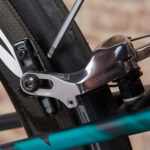Converting your regular bicycle into an electric bike is a fantastic way to boost your riding experience, and at usabikers.net, we’re here to guide you through it. E-bike conversion broadens the utility of commuter bikes and offers an affordable, sustainable alternative to purchasing a brand-new electric bicycle. This transformation not only keeps your trusty steed relevant but also infuses it with modern electric capabilities.
1. Understanding E-Bike Conversion Kits
1.1. What Is an E-Bike Conversion Kit?
An e-bike conversion kit provides all the necessary components to add electric power to a standard bicycle. Conversion kits are available at a lower cost compared to buying a complete e-bike, and they offer a sustainable approach by repurposing a perfectly good bike.
1.2. Why Choose an E-Bike Conversion Kit?
1.2.1. Cost-Effectiveness
E-bike conversion kits are typically more affordable than purchasing a brand new electric bicycle. This allows riders to enjoy the benefits of an e-bike without the hefty price tag.
1.2.2. Sustainability
By converting an existing bike, you’re contributing to sustainability by reusing and upgrading rather than discarding and buying new. It’s an eco-friendly approach that aligns with responsible consumerism.
1.2.3. Customization
Conversion kits allow for a personalized e-bike experience. Riders can choose kits that match their specific needs, whether it’s for commuting, off-road adventures, or leisurely rides.
1.2.4. Familiarity
You get to keep the bike you’re comfortable with, just with added power. No need to adjust to a new frame or riding style.
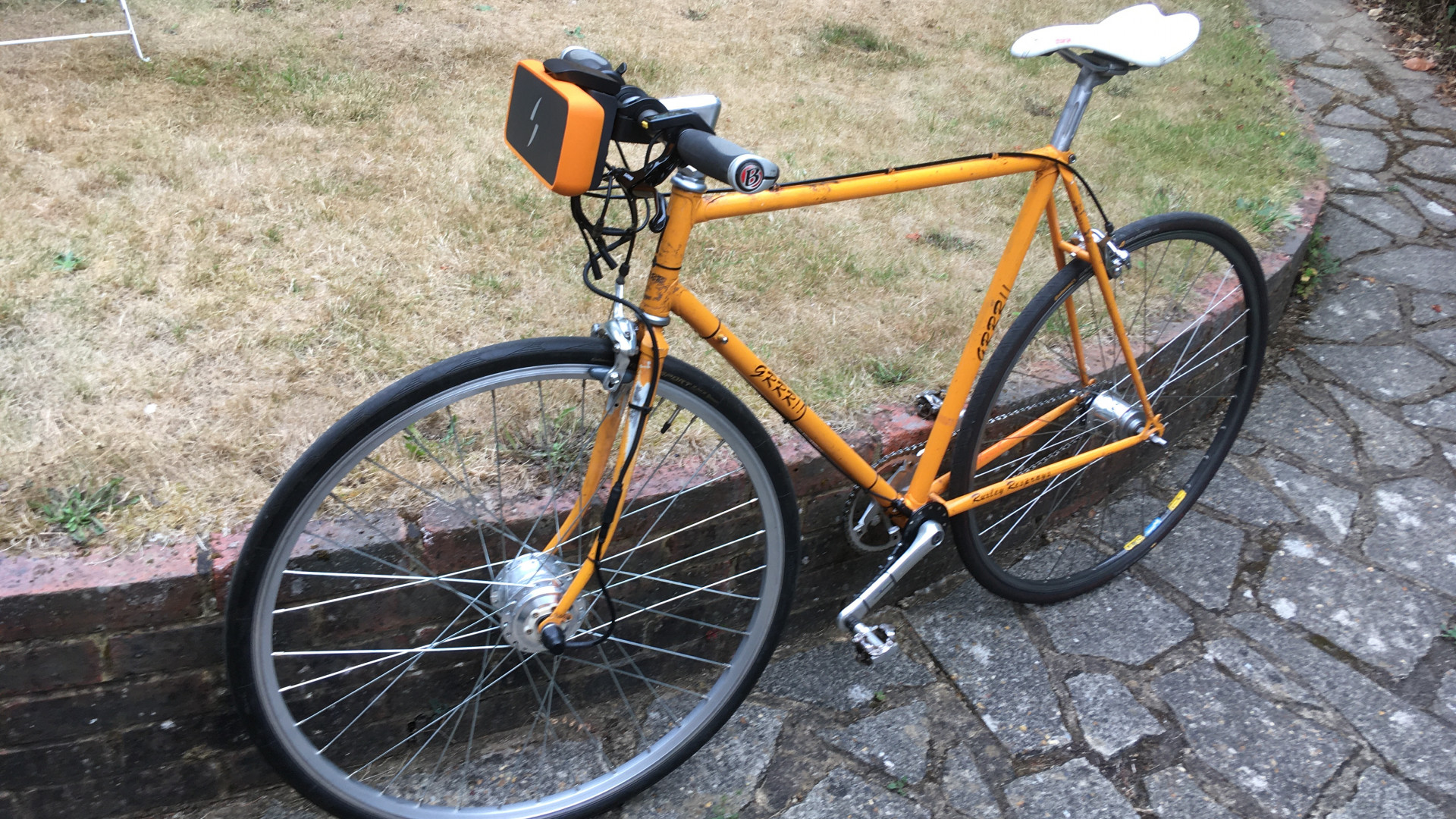 Swytch Max Air Kit ebike conversion kit fitted on a bike
Swytch Max Air Kit ebike conversion kit fitted on a bike
1.3. Key Components of an E-Bike Conversion Kit
An e-bike conversion kit typically includes:
- Motor: Provides the electric power to propel the bike.
- Battery: Stores the energy needed to power the motor.
- Controller: Regulates the power output from the battery to the motor.
- Throttle or Pedal Assist System (PAS): Allows the rider to control the motor’s assistance.
- Display: Shows important information like battery level, speed, and assistance level.
- Wiring and Connectors: Connect all the components together.
2. Can Any Bike Be Converted to Electric?
2.1. General Compatibility
Most bikes can be converted to electric with the right kit and some mechanical know-how. The primary considerations are frame type, wheel size, and brake system.
2.2. Factors Affecting Conversion Suitability
2.2.1. Frame Material and Design
- Aluminum Frames: Generally ideal due to their strength and compatibility with various kits.
- Steel Frames: Suitable, but ensure the kit is compatible with the frame’s dimensions.
- Carbon Fiber Frames: Conversion is possible, but requires careful installation to avoid damage. It’s best to consult with a professional.
2.2.2. Wheel Size and Type
Ensure the conversion kit matches your bike’s wheel size. Common sizes include 26″, 27.5″ (650b), 29″ (700c), and smaller sizes for folding bikes.
2.2.3. Brake System
- Disc Brakes: Generally compatible with most kits.
- Rim Brakes: Also compatible, but may require additional adjustments or modifications.
2.3. Bikes That Are More Challenging to Convert
- Bikes with Integrated Cabling: Can complicate the installation process.
- Bikes with Unusual Frame Shapes: May require custom solutions or modifications.
- Very Old or Rare Bikes: May lack the necessary mounting points or have unique dimensions that make finding compatible kits difficult.
3. Types of E-Bike Conversion Kits
3.1. Hub Motor Kits
3.1.1. Front Hub Motor Kits
- Pros: Easy to install, generally more affordable.
- Cons: Can affect steering and handling, may cause wheel spin on steep inclines.
- Best For: Light to moderate use, flat terrain.
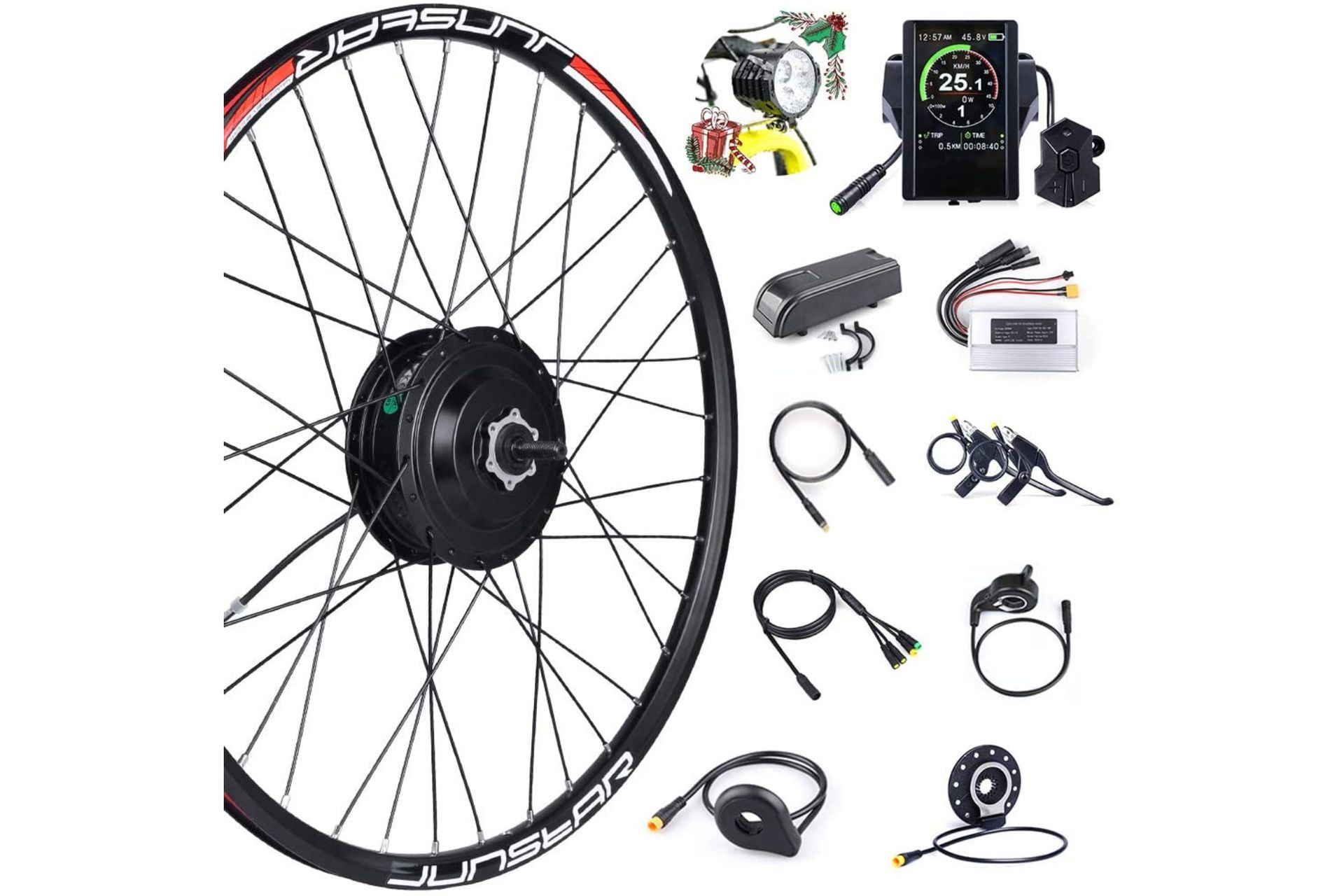 Bafang front hub motor kit which is one of the best electric bike conversion kits
Bafang front hub motor kit which is one of the best electric bike conversion kits
3.1.2. Rear Hub Motor Kits
- Pros: Better traction and weight distribution, more natural riding feel.
- Cons: Can be more complex to install, may require adjustments to the drivetrain.
- Best For: Versatile use, hilly terrain, heavier loads.
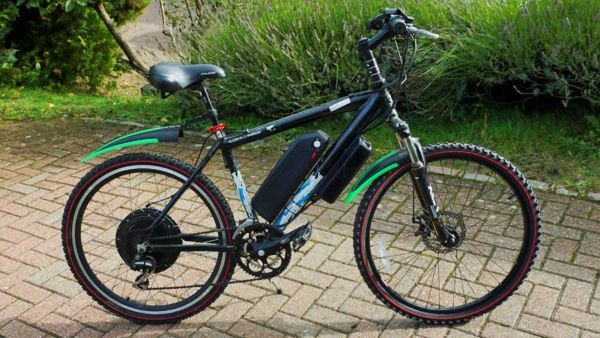 Image shows rear wheel ebike kit fitted to a bike
Image shows rear wheel ebike kit fitted to a bike
3.2. Mid-Drive Motor Kits
- Pros: Excellent weight distribution, efficient power delivery, utilizes the bike’s gears for optimal performance.
- Cons: More expensive, more complex to install.
- Best For: High-performance applications, challenging terrain, long-distance riding.
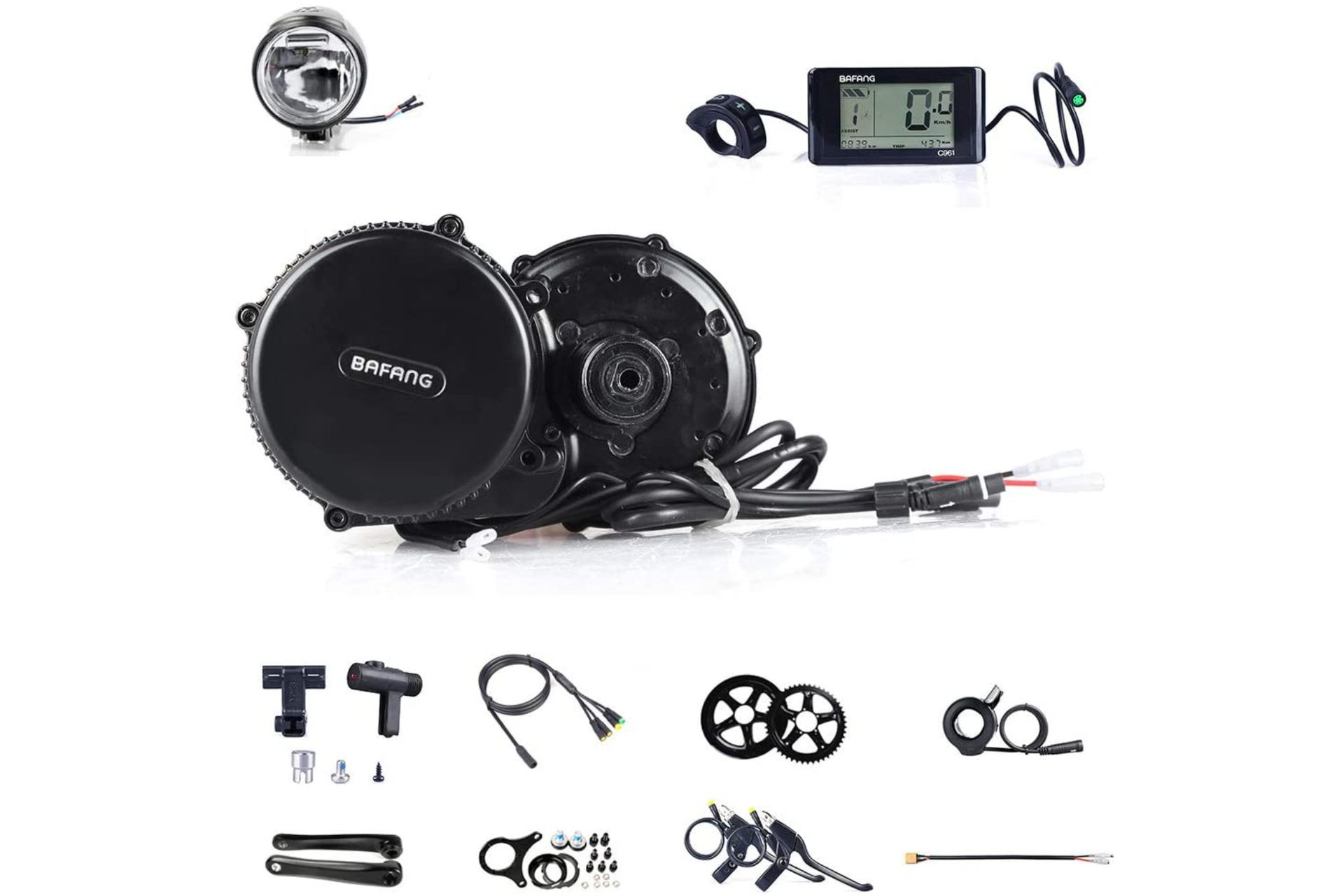 Bafang mid drive which is one of the best electric bike conversion kits
Bafang mid drive which is one of the best electric bike conversion kits
3.3. Friction Drive Kits
- Pros: Easy to install, compatible with a wide range of bikes.
- Cons: Can be less efficient, may cause tire wear, performance can be affected by weather conditions.
- Best For: Occasional use, simple conversions, budget-friendly options.
4. Key Considerations Before Converting Your Bike
4.1. Legal Requirements
4.1.1. US Regulations
In the United States, e-bikes are generally regulated at the state level. However, federal law defines a three-class system for e-bikes:
- Class 1: Pedal-assist e-bikes with a motor that provides assistance only when the rider is pedaling, and ceases to assist when the bike reaches 20 mph.
- Class 2: Throttle-assisted e-bikes with a motor that can propel the bike without pedaling, but ceases to assist when the bike reaches 20 mph.
- Class 3: Pedal-assist e-bikes with a motor that provides assistance only when the rider is pedaling, and ceases to assist when the bike reaches 28 mph.
Many states have adopted these classifications into their laws, allowing Class 1 and 2 e-bikes on bike paths and trails, while Class 3 e-bikes may be restricted to roads or specific bike lanes. It’s essential to check local regulations as they can vary widely.
4.1.2. Ensuring Compliance
When converting your bike, ensure that the motor’s power output and top speed comply with local regulations. Most e-bike conversion kits are designed to meet these requirements, but it’s always a good idea to double-check.
4.2. Budget
4.2.1. Kit Costs
E-bike conversion kits can range from a few hundred to over a thousand dollars, depending on the motor type, battery capacity, and features. Set a budget and research kits that fall within your price range.
4.2.2. Additional Costs
Factor in potential additional costs such as tools, professional installation fees, and upgrades like a new battery or display.
4.3. Technical Skills and Tools
4.3.1. DIY vs. Professional Installation
Assess your mechanical skills and decide whether to install the kit yourself or hire a professional. DIY installation can save money but requires some technical knowledge and the right tools.
4.3.2. Essential Tools
Essential tools for e-bike conversion include:
- Wrench set
- Screwdriver set
- Cable cutters and strippers
- Multimeter
- Bike repair stand
- Torque wrench
4.4. Intended Use
4.4.1. Commuting
For commuting, consider a kit with a reliable motor, decent battery range, and user-friendly controls.
4.4.2. Recreation
For recreational riding, prioritize comfort, handling, and the ability to tackle various terrains.
4.4.3. Off-Road
For off-road adventures, choose a mid-drive motor kit with high torque and a robust battery for tackling steep inclines and rough trails.
5. Step-by-Step Guide to Converting Your Bike
5.1. Preparation
5.1.1. Gather Tools and Materials
Ensure you have all the necessary tools and the e-bike conversion kit on hand.
5.1.2. Read the Instructions
Thoroughly read the conversion kit’s instructions before starting the installation process.
5.1.3. Prepare Your Bike
Clean your bike and inspect it for any damage or wear that may affect the conversion process.
5.2. Installation
5.2.1. Installing the Motor
- Front Hub Motor: Remove the front wheel and replace it with the motor wheel.
- Rear Hub Motor: Remove the rear wheel and replace it with the motor wheel.
- Mid-Drive Motor: Remove the crankset and install the mid-drive motor according to the instructions.
5.2.2. Mounting the Battery
Mount the battery on the frame using the provided mounting hardware. Ensure it is securely attached and doesn’t interfere with pedaling or handling.
5.2.3. Installing the Controller and Display
Mount the controller in a safe location, typically near the battery. Install the display on the handlebars for easy access and visibility.
5.2.4. Wiring and Connections
Connect all the components according to the wiring diagram provided with the kit. Ensure all connections are secure and properly insulated.
 Plug in the cables
Plug in the cables
5.2.5. Installing the Pedal Assist System (PAS) or Throttle
Install the PAS sensor on the crank arm or the throttle on the handlebars, depending on the type of kit.
5.3. Testing and Adjustments
5.3.1. Initial Testing
Turn on the e-bike and test the motor, throttle, and PAS. Ensure everything is functioning correctly.
5.3.2. Adjustments
Adjust the brake levers, cables, and other components as needed to ensure optimal performance and safety.
5.3.3. Test Ride
Take the converted e-bike for a test ride to ensure everything is working smoothly. Pay attention to handling, braking, and motor performance.
5.4. Final Checks
5.4.1. Secure All Connections
Double-check all connections to ensure they are secure and properly insulated.
5.4.2. Cable Management
Use cable ties to manage the wiring and prevent it from interfering with the bike’s moving parts.
5.4.3. Safety Inspection
Perform a final safety inspection to ensure all components are properly installed and functioning correctly.
6. Top E-Bike Conversion Kits on the Market
6.1. Swytch Bike Air eBike Conversion Kit
- Features: Lightweight, easy to install, compact battery.
- Best For: Commuting, urban riding.
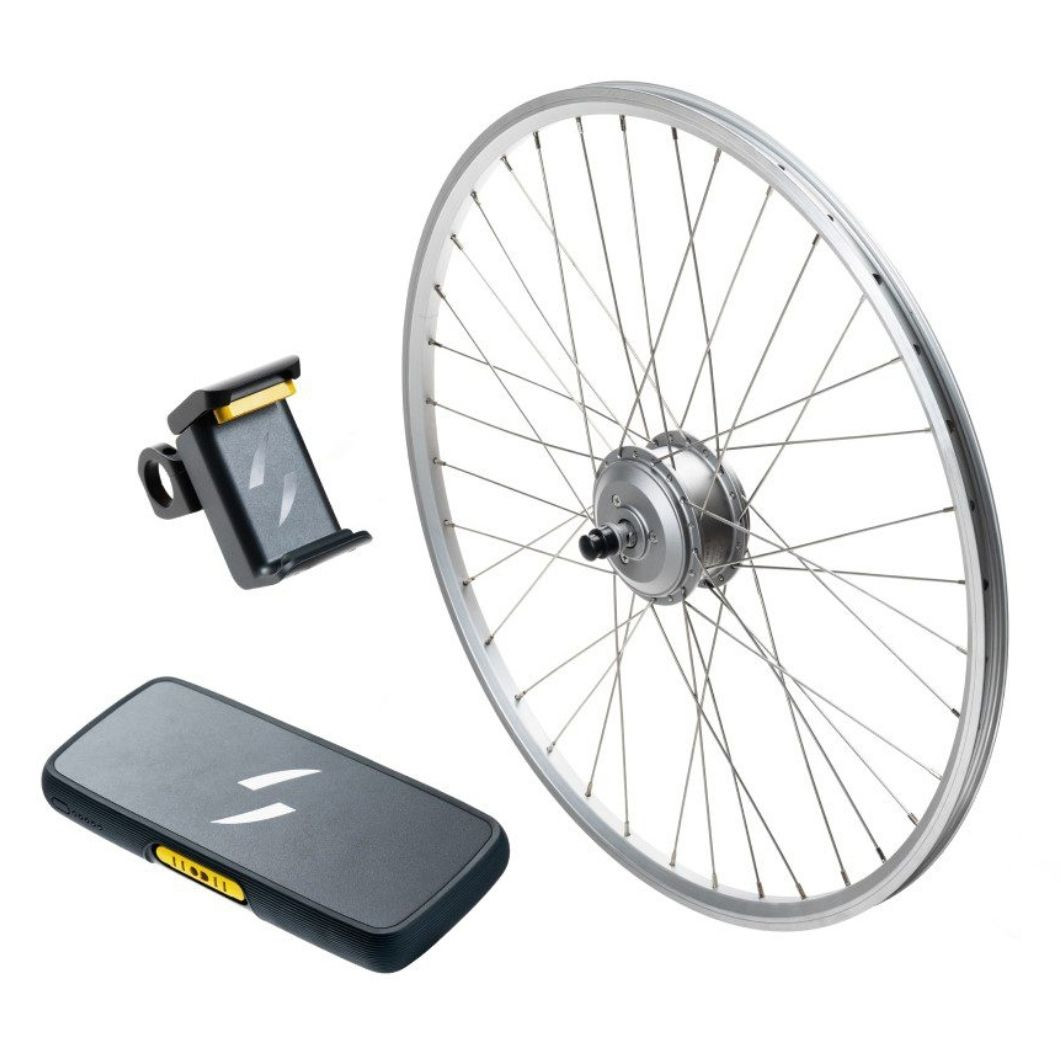 Swytch Bike Air ebike conversion kit
Swytch Bike Air ebike conversion kit
6.2. TongSheng TSDZ2 Mid Drive Motor
- Features: Mid-drive motor, high torque, compatible with various bike designs.
- Best For: Hilly terrain, versatile use.
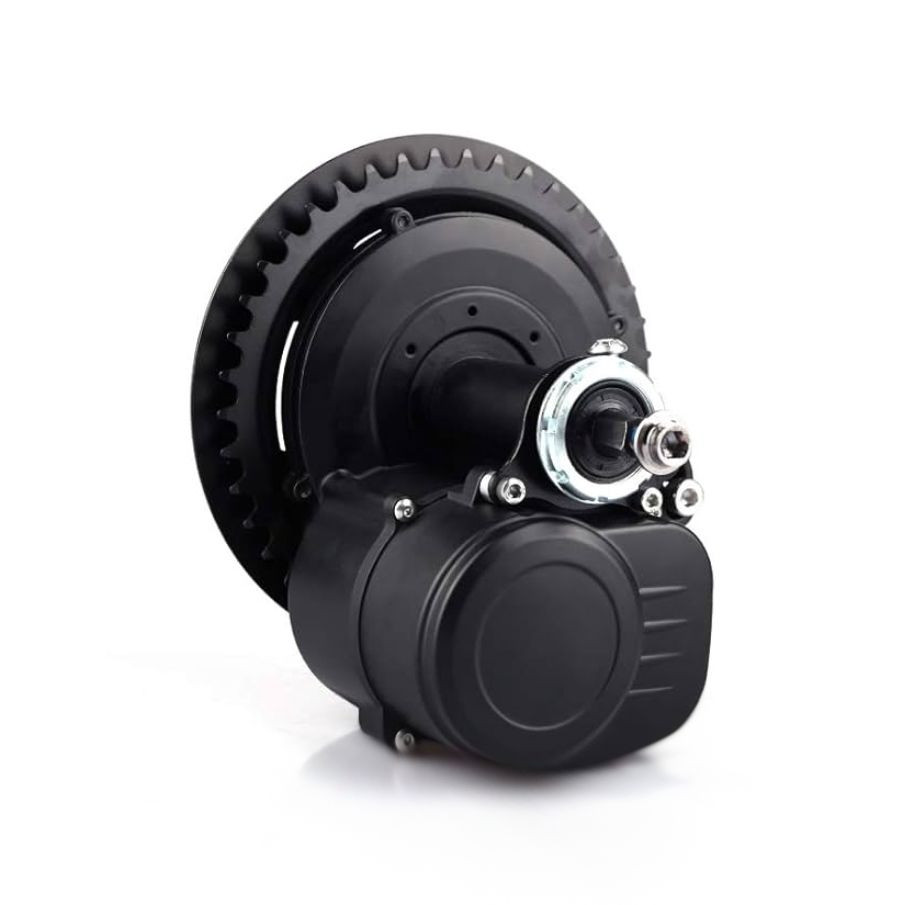 TongSheng TSDZ2 Mid Drive Motor
TongSheng TSDZ2 Mid Drive Motor
6.3. Voilamart 48V Rear Wheel Kit
- Features: Affordable, powerful, rear-wheel drive.
- Best For: Budget-conscious riders, simple conversions.
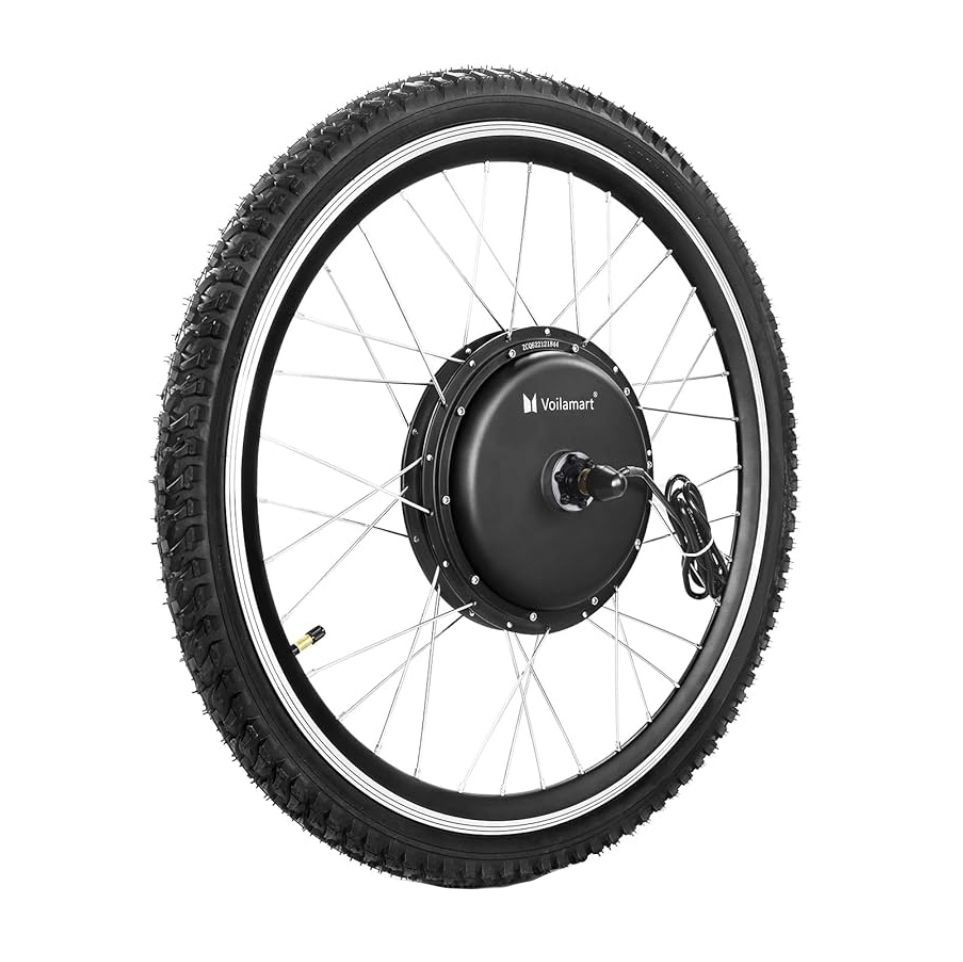 Voilamart rear wheel ebike conversion kit
Voilamart rear wheel ebike conversion kit
6.4. Skarper DiscDrive System
- Features: High compatibility, easy to fit, strong performance in turbo mode
- Best For: Speed of setup, compatibility with various bikes
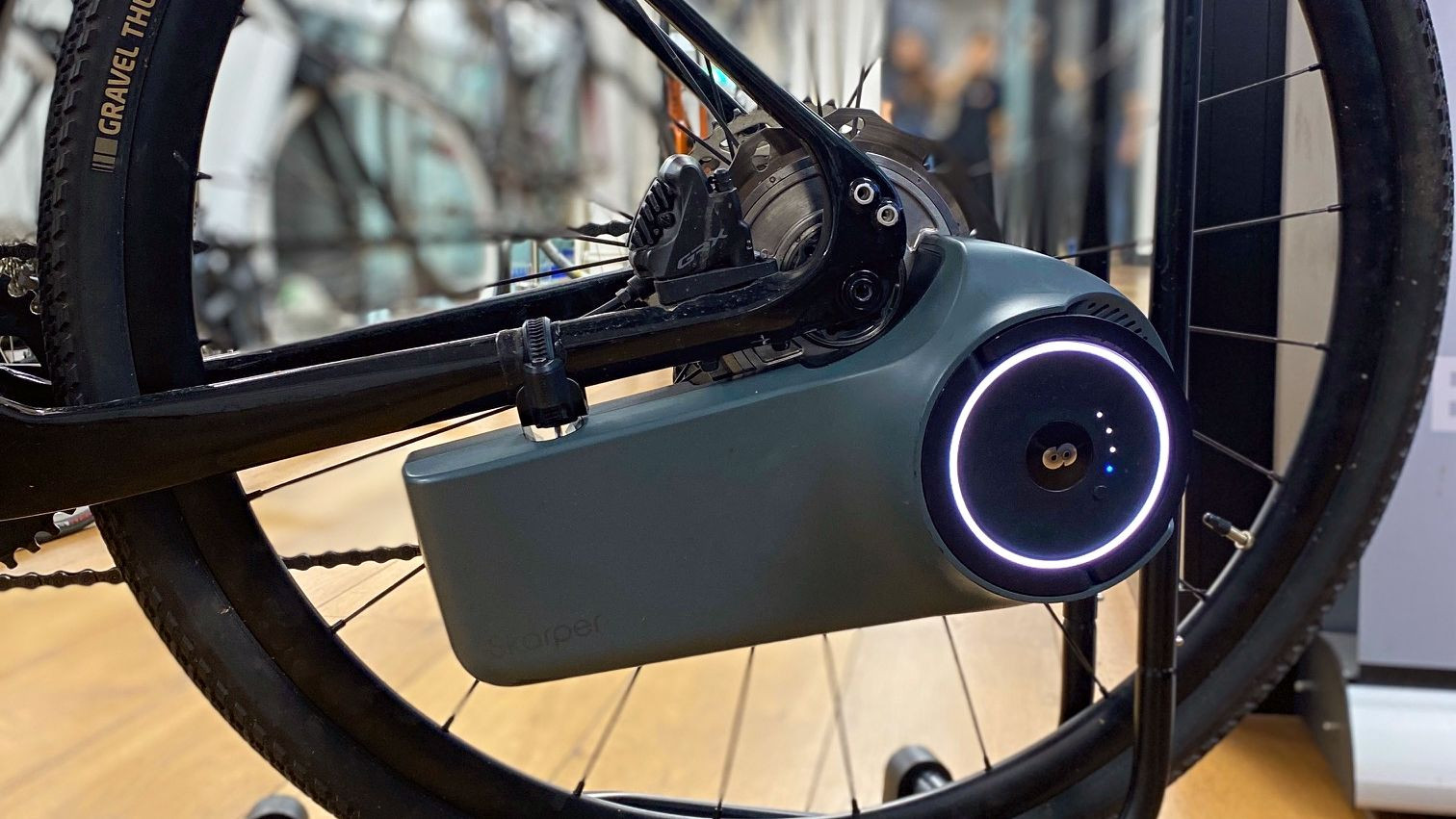 Skarper ebike conversion kit mounted to the rear triangle of a bicycle
Skarper ebike conversion kit mounted to the rear triangle of a bicycle
6.5. Bafang Mid Motor Kit
- Features: High torque, suitable for off-road, crank-driven power.
- Best For: Off-road adventures, steep inclines.
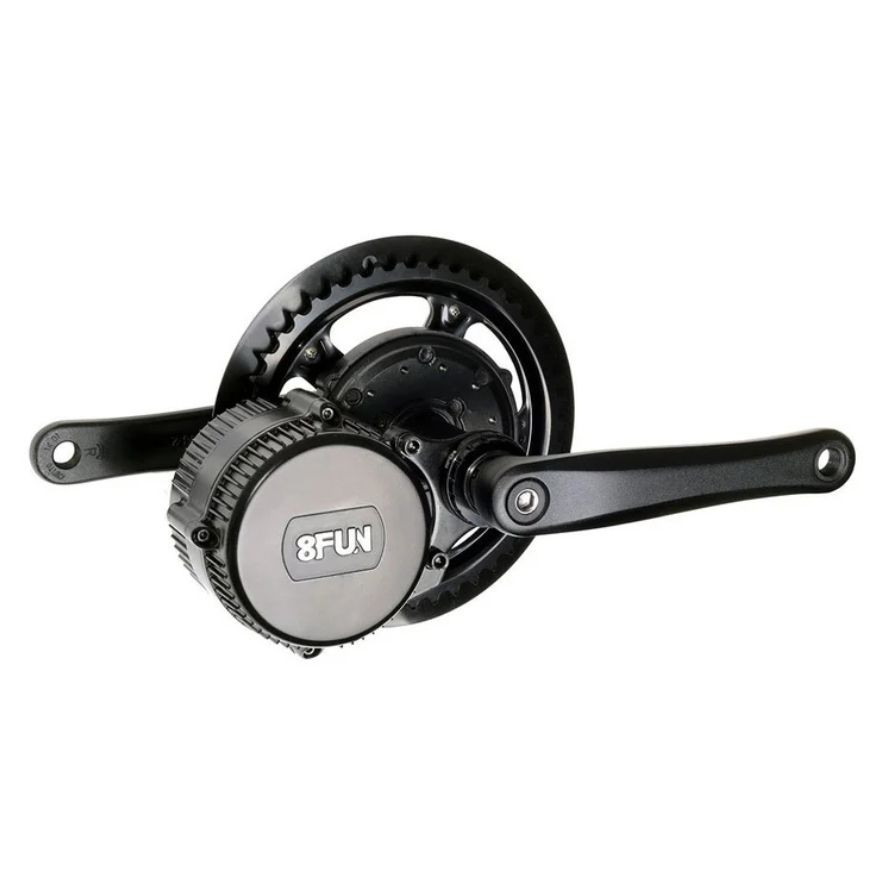 Bafang mid motor ebike conversion kit
Bafang mid motor ebike conversion kit
6.6. Bafang Front Hub Motor Kit
- Features: Good value, less bulky, front hub motor.
- Best For: Urban riding, budget-friendly option
 Bafang front hub motor kit which is one of the best electric bike conversion kits
Bafang front hub motor kit which is one of the best electric bike conversion kits
7. Maintaining Your Converted E-Bike
7.1. Battery Care
7.1.1. Charging Habits
Follow the manufacturer’s recommendations for charging your e-bike battery. Avoid overcharging or letting the battery completely discharge.
7.1.2. Storage
Store the battery in a cool, dry place away from direct sunlight and extreme temperatures.
7.1.3. Lifespan
E-bike batteries typically last for 500-1000 charge cycles. Replace the battery when it no longer holds a sufficient charge.
7.2. Motor Maintenance
7.2.1. Cleaning
Keep the motor clean and free from dirt, debris, and moisture.
7.2.2. Inspections
Regularly inspect the motor for any signs of damage or wear.
7.2.3. Professional Servicing
Consider professional servicing for the motor to ensure it is functioning optimally.
7.3. General Bike Maintenance
7.3.1. Tire Pressure
Maintain proper tire pressure for optimal performance and safety.
7.3.2. Brake Adjustments
Regularly adjust the brakes to ensure they are functioning correctly.
7.3.3. Chain Lubrication
Keep the chain lubricated for smooth and efficient operation.
8. Troubleshooting Common Issues
8.1. Motor Not Working
8.1.1. Check Connections
Ensure all connections are secure and properly connected.
8.1.2. Battery Level
Verify that the battery is fully charged.
8.1.3. Controller Issues
Check the controller for any signs of damage or malfunction.
8.2. Battery Not Charging
8.2.1. Charger Issues
Test the charger with another device to ensure it is working correctly.
8.2.2. Battery Damage
Inspect the battery for any signs of damage or swelling.
8.2.3. Connection Problems
Check the connections between the battery and the charger.
8.3. Performance Issues
8.3.1. Tire Pressure
Ensure the tires are properly inflated.
8.3.2. Brake Drag
Check for brake drag and adjust the brakes as needed.
8.3.3. Motor Performance
Inspect the motor for any signs of wear or damage.
9. The Benefits of Riding an Electric Bike
9.1. Health and Fitness
9.1.1. Increased Activity
E-bikes encourage more frequent and longer bike rides, promoting physical activity.
9.1.2. Adjustable Assistance
E-bikes allow riders to adjust the level of assistance, making it easier to tackle hills and challenging terrain.
9.2. Environmental Benefits
9.2.1. Reduced Emissions
E-bikes produce zero emissions, reducing your carbon footprint.
9.2.2. Sustainable Transportation
E-bikes are a sustainable transportation option that reduces reliance on cars.
9.3. Cost Savings
9.3.1. Reduced Fuel Costs
E-bikes eliminate the need for gasoline, saving you money on fuel.
9.3.2. Lower Maintenance Costs
E-bikes typically have lower maintenance costs compared to cars.
9.4. Convenience and Accessibility
9.4.1. Easier Commuting
E-bikes make commuting easier and more enjoyable, especially in hilly areas or against strong winds.
9.4.2. Extended Range
E-bikes allow you to travel longer distances with less effort, expanding your riding range.
10. Enhancing Your Biker Lifestyle with usabikers.net
At usabikers.net, we’re passionate about the biker community and culture. Whether you’re a seasoned rider or just starting, we offer a wealth of information and resources to enhance your experience.
10.1. Community and Connection
Join our vibrant community of bikers to connect with like-minded individuals, share experiences, and get advice.
10.2. Comprehensive Information
Access detailed articles, reviews, and guides on e-bikes, motorcycles, gear, and more.
10.3. Events and Rallies
Stay up-to-date on the latest biker events, rallies, and gatherings across the USA.
10.4. Expert Advice
Get expert advice on maintenance, repairs, and upgrades to keep your bike running smoothly.
11. Frequently Asked Questions (FAQs)
11.1. Can I convert any bike to electric?
Yes, most bikes can be converted to electric with the right kit, but consider the frame material, wheel size, and brake system.
11.2. How much does it cost to convert a bike to electric?
The cost varies from a few hundred to over a thousand dollars, depending on the kit’s features and battery capacity.
11.3. Is it difficult to install an e-bike conversion kit?
It depends on your mechanical skills. DIY installation is possible, but professional installation is recommended for those less experienced.
11.4. What are the legal requirements for e-bikes in the US?
E-bikes are generally regulated at the state level, but federal law defines three classes: Class 1, Class 2, and Class 3, each with different speed and assistance limitations.
11.5. What type of motor is best for my e-bike conversion?
It depends on your intended use. Front hub motors are good for light use, rear hub motors are versatile, and mid-drive motors are best for high-performance applications.
11.6. How long does an e-bike battery last?
E-bike batteries typically last for 500-1000 charge cycles, depending on usage and maintenance.
11.7. Can I use my e-bike in the rain?
Yes, most e-bikes are water-resistant, but avoid submerging the motor and battery in water.
11.8. How do I maintain my e-bike battery?
Follow the manufacturer’s recommendations for charging and storage. Avoid overcharging and extreme temperatures.
11.9. What tools do I need to install an e-bike conversion kit?
Essential tools include a wrench set, screwdriver set, cable cutters, multimeter, and bike repair stand.
11.10. Where can I find reliable e-bike conversion kits?
You can find reliable e-bike conversion kits at reputable online retailers, local bike shops, and directly from manufacturers.
12. Conclusion
Converting your bike to electric opens up a world of possibilities, from easier commutes to extended recreational rides. By understanding the different types of kits, considering your needs, and following the installation steps, you can transform your trusty bicycle into a powerful and efficient e-bike. At usabikers.net, we’re here to support you every step of the way with expert advice, community connections, and comprehensive resources. Join us and elevate your biker lifestyle today!
Ready to start your e-bike conversion journey? Visit usabikers.net now to explore our detailed articles, participate in our community forums, and find the perfect conversion kit for your bike. Let’s ride into the future together!
For further assistance, you can reach us at:
- Address: 801 Sturgis Main St, Sturgis, SD 57785, United States
- Phone: +1 (605) 347-2000
- Website: usabikers.net


